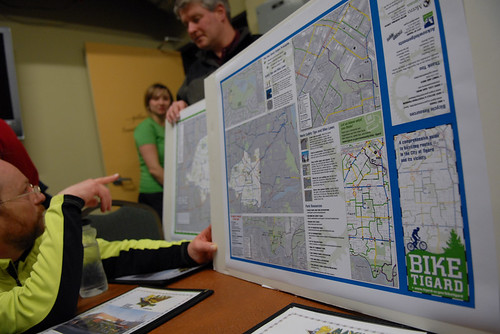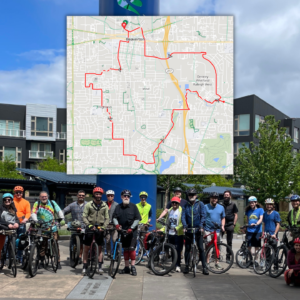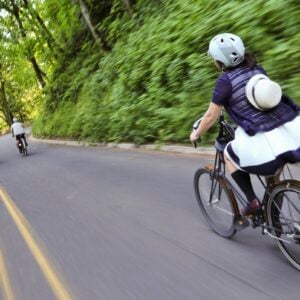
(Photo: J.Maus/BikePortland)
As we reported Wednesday, Portland’s proposed Flanders Crossing Active Transportation Bridge across Interstate 405 made the cut for probable funding from a two-year, $45 million state program.
On Friday, the state released a full list of 75 project rankings from the final review committee for the lottery-backed Connect Oregon program.
Of those, 37 fit into the top-priority $45 million worth of projects.
Among the tentative winners were three multi-use path segments in the metro area: $700,000 for the Tigard Street Trail in Tigard; $400,000 for Waterhouse Trail Segment 4 in the Tualatin Hills Park and Recreation District; and $1.2 million for the Kronberg Park Multi-Use Trail in Milwaukie.
Other bike-related projects from the area didn’t appear to make the cut. Those included trail improvements from Memorial Park to Boones Ferry Park in Wilsonville; a better multimodal crossing of the Burlington Northern Santa Fe railroad tracks at Naito Parkway in northwest Portland; an off-street section of the Red Electric Trail in southwest Portland; Phase IV of the Gresham Fairview Trail; and a Bike Hub at the Mount Hood Villages.
Advertisement
Various bike-related projects around the state also seemed to score funding, including paths and trail segments in Yamhill County, Redmond and Island City.
Mass transit projects fared relatively well in this round of the program, which now in its sixth two-year cycle. Four of five transit projects around the state made the tentative cut for funding, taking in 15 percent of total costs, the highest ratio to date for transit.
The other categories are aviation, marine/ports and rail.
The Oregon Transportation Commission, the gubernatorially nominated committee that oversees the Oregon Department of Transportation, will hold a public hearing on the funding list July 21 and make final decisions at its Aug. 18-19 meeting in Klamath Falls.
— Michael Andersen, (503) 333-7824 – michael@bikeportland.org
Our work is supported by subscribers. Please become one today.







Thanks for reading.
BikePortland has served this community with independent community journalism since 2005. We rely on subscriptions from readers like you to survive. Your financial support is vital in keeping this valuable resource alive and well.
Please subscribe today to strengthen and expand our work.
I’m excited about the Yamhelas Westsider Trail!
Too bad the Naito project didn’t make the cut. The Flanders Bridge is great, but to really succeed it needs to be part of a continuous corridor from the Steel Bridge to the foot of the West Hills. Hopefully the City can find another way to fund it. Here’s the most recent bikeportland story about the proposed solution to the Naito gap:
http://bikeportland.org/2015/12/08/169829-169829
The public hearing and the meeting in August might change that, but we’ll have to see. Tri-Met is, according to Willamette Week, looking at a possible MAX line along the 99W corridor to Brudgeport Village, assuming that it passes muster in a region wide election. Could a bike route become part of that project?
Rails are anchored in concrete or steel are stronger than wooden ties. a curb and a paved or concrete path on both sides or at least one side within the right of way will work. Myself I will be riding MAX with my bike, or taking WES.
Yes!
Bike paths are a great idea. To fund them I think the state should issue a licence plate and an operator licence for each and every bicycle, sort of like what is done with motor vehicles. Another possibility could be a required liability insurance sold by a govt agency, and also place a tax on all bicycle related sales. Toll bikeways might also be considered as an additional source for funding.
User paying for the bicycle roadways and related items will result in a great feeling of accomplishment for all concerned.
Which makes it more expensive to use the worlds second most efficient form of ground transportation..
Ha ha ha, good one.
Instead I think we should institute a payroll tax to pay for bike and pedestrian infrastructure. Non automotive trips are cheaper to accommodate than automotive trips. With transit this sort of tax is justified because it’s not just the riders who benefit from the system, in much the same way it’s not just people walking and biking who benefit from their accommodations. 0.1% of payroll, that’s $1,500 a year for a small business with $1.5 million payroll. To be phased in over a decade. For reference, last year Trimet voted to increase the transit payroll tax, from 0.7237% to 0.8237%. Phased in over a decade. Trimet was projected to bring in 4.3 million/year initially, 43 million/year once phased in. Whether this tax should be limited to Portland or apply to the entire trimet transit district is up for debate, I would prefer the latter, but the former would be a good start too.
Yes , taxes on bikes are a great idea! Unfortunately it’s way too complicated for those silly elected officials to figure out how to have one tax for bikes and another for motorized vehicles.
So let’s make it simple: one vehicle tax for every vehicle, based on gross vehicle weight. Say, a dollar a pound. I’d gladly pay $19 a year for my commuter bike knowing that mr. Suburban is paying $5600 dollars a year. Fair’s fair.
I’m very happy that the Waterhouse Trail segment made the list. It will really help to solve the poor connection across Hwy 26. It’s still won’t be perfect, but at least it removes the circuitous detour through the neighborhood. I hope that part of the project involves rebuilding the Boardwalk to the new connection. The current one was clearly not built with bikes in mind.
Where is a pedestrian / bike bridge over Highway 26 in Washington County needed the most? The Rock Creek Trail goes underneath the highway.
Something to connect Sunset TC to the path along 26 would be nice.
SW Wilshire has that connection but many nearby roads have 4 (yes 4) lanes and aren’t all 25 mph.
SW Wilshire lacks any bicycle facilities and crosses a highway on-ramp. There’s definitely quite a bit of room for improvement.
Wilshire is 25mph and generally peaceful. The biggest problem is trying to navigate from the TC to the path if you don’t know the way.
Huh, you must have a different experience than me. I find riding on that stretch to be quite stressful.
It could be the cut-thru auto traffic. The roads there are very wide and lack protected bike lanes.
I assume you’re talking about the long block on Wilshire between Marlow and the on-ramp? I’m generally there at about 5:30am and 4:00pm, so traffic volume is lighter than usual, and I ride about 20mph, so that’s probably why I haven’t had much trouble. I’m not sure that having a bike lane there would do anything to improve it — you’d still have to ride pretty much in the middle of the lane in both directions to stay clear of the parked cars. If anything, I’d prefer sharrows.
For me the worst part of the Sunset TC crossing is getting to the Sunset TC from the north. Barnes is HORRIBLE, and the bike lane on Trimet’s road to the Sunset TC is always covered in thorns, gravel & broken glass. They don’t regularly maintain it and only do it by request.
There are plenty of places where a bike/pedestrian crossing would be helpful. In my opinion (biased towards where I travel most often) the three most important areas that could use improvement would be:
1) The area near the Waterhouse Trail (approximately where Bethany Blvd crosses 26). I’m disappointed that the bike and pedestrian facilities are so poor on that overpass, considering it was just rebuilt (expanded) in the past few years.
2) The future Westside Trail. (Connecting Greenbrier pkwy south of 26, and Cornell to the north) This is a project that THPRD has planned, but no funding has been identified.
3) Improving the walking and biking on (or around) 185th in the Tanasbourne/Rock Creek area. The stretch of 185th between Cornell and Bronson is my least favorite area to go through no matter what mode of transportation I’m using.
The only good crossings I can think of are the path from the Sunset TC and the Rock Creek underpass. The rest are terrible.
Always happy for more infrastructure, but I also find myself using the infrastructure we already have – especially on the Eastside – less. None of this is news to Eastside cyclists, but the camps moved from Cartlandia are now spread thru other areas along the path…very dense from Flavel east, less dense but common along the 205 path, the Peninsula crossing, and on the stretch from Oaks Park to OMSI. A few have moved back West of Flavel. I’ve been riding those paths anyway because it’s better than the road and I haven’t wanted to abandon the paths, but I’m completely done with the 205 path after navigating a group of men camping and hanging out on section hidden by the high concrete wall. Not fun. Not worth it. So I’m riding more on roads and having a harder time getting to some great places to ride…along the Columbia, out toward Mult Falls, etc. And when the choice is getting in a quick post-work ride along heavily camped areas of the path or dealing with rush hour traffic, sometimes I’m just riding less.
This problem is ubiquitous in Oregon, from Ashland to PDX. However, I’ve been pleasantly surprised during some recent trips to NorCal to find that the bike paths there are not becoming dangerous camps. I suspect the difference has a lot to do with the fact that many jurisdictions in CA are returning to funding law enforcement and focussing on what our cops dismiss as mere “quality of life” crimes. I even saw some traffic law enforcement going on, which has become nonexistent hereabouts.
Aah with agast, exclamatory enthusiasm, cheerful nods of tears shed, yes,
yes, carry on and THANK YOU you dearest bicyclists imagining our/your/your owns’ future – sans – BURNING carbo hydrates.
Dear Loves, cancel your vacation air space, palm trees poisonings, e t c.
Looking at the list I just want to cry. It’s all about airports (that probably shouldn’t exist), freight rail and oddities with just about nothing of note for the economic future of transportation. Welcome back to 1960.
Worst of all, the #1 priority is a giant parking lot.
I wish the Gresham Fairview Trail Phase IV was in the mix. It would connect the trail to the I-84 Multi-Use path and get one critical step closer to the Marine Drive Trail connection, the fifth and final phase connecting the Springwater and the Marine Drive Trail.
And create a safe connection between several huge employers in that industrial area, and their employees to the south that really want to safely ride to work. The current gap is so small, it is extremely frustrating that it is taking so long to fill it.
Where can we find more information on the trail projects? I know the Tigard Rail Trail has been paved and done for several months now, I’d like to know what else they’re doing… maybe extending it? That would be cool.
http://www.oregonmetro.gov/event/sixth-annual-barbara-walker-regional-trails-fair/2016-06-22
What about online resources? This isn’t a convenient time or location for me.
http://resolvearchitecture.com/tigard-st-heritage-trail.html
Contact Mel Hui or Robert Spurlock at Metro (503-797-1900). They can tell you how best to stay in the loop on specific regional trail projects.
Thank you!
Tigard has floated ideas of buying property on the north side of the Tigard Street Trail to build a skate park. They want more benches and perhaps trees along the new trail.
http://www.tigard-or.gov/lqc_projects.php
They should spend the money on completing the gap in the Fanno Creek Trail from Woodard Park to Grant St.
The Trolley Trail between the Springwater and the end of the Orange Line was built as part of the Orange Line project, so there is a precedent there. Rails alongside trails are becoming increasingly popular back East, so having one as part of the 99W corridor line would make sense.
I heard the Trolley Trail near Oak Grove was designed and built within 6 years.
Wow, some disappointments for sure. The ones I would personally have ranked highest:
– Naito railroad crossing: a major gap in a critical bikeway.
– Red Electric: the lack of a bike route between Portland and Beaverton that is safe and doesn’t require big climbs is a huge embarrassment. You can choose relatively easy climbing on a route that isn’t particularly safe (Beaverton-Hillsdale Highway) or one of several relatively safe but circuitous routes on side streets that involve major climbing. The “#1” bike city in America still can’t provide a reasonable bike route to its largest suburban employment center?